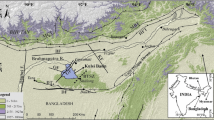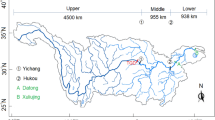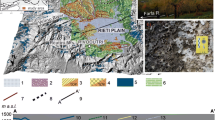Abstract
The stratigraphical cross-sections of the Yangtze River incised-valley near the No.1, No.3 and No.4 Nanjing Yangtze River bridges were established with respective bore date and documents. By 14C age analysis of the samples of four drilling cores near the No.4 Bridge (to be built), we can find that the time range of paleo-valley is dated in the LGM at a depth of −60 m to −90 m near Nanjing. It is also indicated that the deep incised-valley channel was narrow and the river flowed swiftly. The ancient Yangtze River deep channel presented partially and deeply incised features near the No.1 Bridge. According to previous publications, much research has been done on the main paleo-channel of the Yangtze River, but few results have been achieved on discharge estimation. In this paper, the incipient velocity and average velocity of the LGM was calculated with \( V_c = 4.60d^{{1 \mathord{\left/ {\vphantom {1 3}} \right. \kern-\nulldelimiterspace} 3}} h^{{1 \mathord{\left/ {\vphantom {1 6}} \right. \kern-\nulldelimiterspace} 6}} ,V_c = 1.281g\left( {13.15.\frac{h} {{d_{95} }}} \right)\sqrt {gd} ,V \approx 6.5u_* \left| {\frac{h} {{d_{90} }}} \right|^{\tfrac{1} {6}} \), etc., in terms of the river shape, sedimentary grain size and sequences near the No.3 and No.1 bridges. Moreover, the discharge in Nanjing reach of the Yangtze River during the LGM has been estimated to be around 12,000–16,000 m3/s according to the relationship of discharge, velocity of flow and cross-section.
Similar content being viewed by others
References
Baker V R, Benito G, Rudoy, 1993. A paleohydrology of Late Pleistocene superflooding, Altay Mountains, Siberia. Science, 259: 48–350.
Cao Guangjie, Wang Jian, Qu Guixian, 2006. Formation & sedimentary characteristics of the Yangtze River incised-valley in Nanjing. Journal of Henan University (Natural Science), 36(1): 66–69. (in Chinese)
Cao Guangjie, Wang Jian, Xiong Wanying et al., 2006. Sedimentary characteristics of the Yangtze River’s paleovalley in Nanjing since the Last Glacial Maximum. Marine Geology & Quaternary Geology, 26(1): 23–28. (in Chinese)
Dou Guoren, 1999. Incipient motion of coarse and fine sediment. Journal of Sediment Research, (6): 1–9. (in Chinese)
Fang Jinqi, 1990. The numerical analog of the sea-level rise affecting the Yangtze River middle and lower reaches since late ice age. Science in China (Series B), 20(8): 870–878. (in Chinese)
Guo Xumin, 1983. Evolution of sedimentary environment of the Changjiang estuary area since the late stage of late Pleistocene. Chinese Journal of Geology, 18(4): 402–408. (in Chinese)
Han Qiwei, He Mingmin, 1999. The Incipient Disciplinarian and Incipient Velocity of Sediment. Beijing: Science Press. (in Chinese)
Institute of Geography, CAS, Yangtze River Institute of Water Resources and Hydro-Power Research, 1985. Channel Properties and Evolution in the Yangtze River’s Middle and Lower Reaches. Beijing: Science Press, 60–61. (in Chinese)
Jiang Sishan, Ang Chaohai, Yang Huicheng et al., 1986. A preliminary research on the ancient channel of the Qinhuai River and the age of its sediments. Acta Geologica Sinica, 60(1): 89–101. (in Chinese)
Judith Maizels, 1990. Raised channel systems indicators of palaeohydrologic change: A case study from Oman. Palaeogeography, Palaeoclimatology, Palaeoecology, 76(3/4): 241–277.
Kemp Justine, 2007. Evidence for regionally wet conditions before the LGM in southeast Australia: OSL ages from a large palaeochannel in the Lachlan Valley. Journal of Quaternary Science, 22(5): 423–427.
Lambeck Kurt, 1990. Late Pleistocene, Holocene and present sea-levels: Constraints of future change. Palaeogeography, Palaeoclimatology, Palaeoecology, 89: 205–217.
Li Congxian, Zhang Guijia, 1995. A sea-running Changjiang River during the last glaciation? Acta Geographica Sinica, 50(5): 459–463. (in Chinese)
Liu Jian, Yu Ge, Chen Xiang et al., 2002. Simulation of climate during the mid-Holocene and the Last Glacial Maximum in East Asia. Progress in Nature Science, 12(7): 713–720. (in Chinese)
Liu Yu, He Jinhai, Liu Weiliang et al., 2007. MM5 simulations of the China regional climate of the LGM (II): Influences of land area, vegetation, and large-scale circulation background. Acta Meteorologica Sinica, 12(2): 151–159. (in Chinese)
Maizels J K, 1983. Palaeovelocity and palaeodischarge determination for coarse gravel deposits. In: Gregory K (ed.). Background to Palaeohydrology. Chichester: Wiley, 101–139.
Qian Yun, Qian Yongfu, Zhang Yaocun, 1998. Study on scenarios and mechanism of the regional climate change of East Asia in the Last Ice-age. Scientia Atmospherica Sinica, 22(3): 283–293. (in Chinese)
Rotnicki K, 1991. Retrodiction of palaeodischarges of meandering and sinuous rivers and its palaeoclimatic implications. In: Starkel L et al. Temperate Palaeohydrology. Chichester: Wiley, 431–470.
Sidorchuk A Yu, Borisova O K, 2000. Method of paleogeographical analogues in paleohydrological reconstructions. Quaternary International, 72(1): 95–106.
Williams G P, 1988. Paleofluvial estimates from dimensions of former channels and meanders. In: Baker V et al. Flood Geomorphology. Chichester: Wiley, 321–334.
Xia Dongxing, Liu Zhenxia, 2001. Tracing the Changjiang River’s flowing route into the sea during the last glacial maximum. Acta Oceanologica Sinica, 23(5): 88–95. (in Chinese)
Yang Dayuan, 1986. The paleoenvironment of the mid-lower regions of Changjiang in the full-glacial period of Late Pleistocene. Acta Geographica Sinica, 41(4): 302–310. (in Chinese)
Yang Dayuan, 1989. Changes of water level in the mid-lower reaches of the Changjiang River since the end of Late Pleistocene. Quaternary Sciences of China, 8(1): 114–119. (in Chinese)
Yang Huairen, 1987. Quaternary Geology. Beijing: Higher Education Press. (in Chinese)
Yang Huairen, Han Tongchun, Yang Dayuan et al., 1983. Processes and causal mechanism of migrations of the Changjiang since Late Pleistocene. Journal of Nanjing University (Natural Science), (2): 341–350. (in Chinese)
Yang Huairen, Xu Xin, Yang Dayuan et al., 1995. Environmental Changes and Ecosystems in the Yangtze River’s Middle and Lower Reaches. Nanjing: Hohai University Press, 86–93. (in Chinese)
Yu Ge, Chen Xing, Liu Jian et al., 2000. Simulation and diagnosis of East Asian climate in the Last Glacial Maximum. Chinese Science Bulletin, 45(20): 2153–2159. (in Chinese)
Zheng Yiqun, Yu Ge, Wang Sumin et al., 2002. Simulations of Last Glacial Maximum climate of East Asia by regional climate model. Science in China (Series D), 32(10): 871–880. (in Chinese)
Zhu Yongqi, 1984. Primary study on the physiognomy in East China Sea continental shelf. In: Collection of Studies on the East China Sea. Beijing: China Ocean Press, 65–70. (in Chinese)
Author information
Authors and Affiliations
Corresponding author
Additional information
Foundation: National Basic Research Program of China, No.2003CB415201-8; National Natural Science Foundation of China. No.40871010; Doctorate Foundation of Linyi Normal University, No.BS08021
Author: Cao Guangjie (1964–), Ph.D and Professor, specialized in Late Quaternary environmental evolution in the Yangtze River Delta.
Rights and permissions
About this article
Cite this article
Cao, G., Wang, J., Wang, L. et al. Characteristics and runoff volume of the Yangtze River paleo-valley at Nanjing reach in the Last Glacial Maximum. J. Geogr. Sci. 20, 431–440 (2010). https://doi.org/10.1007/s11442-010-0431-3
Received:
Accepted:
Published:
Issue Date:
DOI: https://doi.org/10.1007/s11442-010-0431-3




